To Cape Adare
We heard that in New Jersey it’s been snowy and very cold. So be proud! You’re in a place that’s colder than Antarctica right now.
After four days of work in the waters of the central Ross Sea, the Palmer headed northwest toward the opening of the Southern Ocean. The northernmost end is called Cape Adare. It’s famous for its howling winds, but as we neared it the weather just got calmer and calmer. I’m wondering if our luck will hold or if we should start getting the seasick medication out.
We saw plenty of penguins in the water. Cape Adare has the largest breeding colony of Adélie penguins in the world—more than half a million birds—and right now the parents have some very large and very hungry chicks to feed. Read on through the slideshow for more about what we saw today:
- The day started with bright sun and a ruffling breeze. Chris was knocked out by the deep blue of the water, and he ran up to the bridge to take this photo. ‘People are going to think I photoshopped this,’ he said, ‘but I didn’t touch a thing.’ Alas, the bright weather was not to last. The winds remained calm, but clouds settled in and became mist, then light snow.
- Icebergs started appearing on the horizon in early afternoon, and by 5 p.m. we were passing enormous tabular icebergs. This one was about 5 miles away. The top was about level with our eyes as we stood on the bridge, meaning it was roughly 60 feet above the water. And as you’ve probably heard, that means the berg extends about another 500 feet below the water.
- Other icebergs floated lower in the water. This one seemed to have collided with another berg—there was a jumble of fractured blocks along one side. A layer of snow on the flat surface has broken into blocks and most of it has slid off. We saw southern giant petrels (heavy, albatross-like birds) perched on a ledge along one side, and brilliant snow petrels coursed over the highest points.
- Krill are one of the main food sources for birds, whales, and seals in the Ross Sea. You’ll often read that krill are small, shrimp-like creatures, and this close-up offers proof—check out the big googly eyes, pink color scheme, and forest of legs, just like shrimp. Sometimes they’re not even all that small. This one (photographed under a 10x dissection microscope) was bigger than a piece of macaroni—a pretty good morsel for an Adélie penguin.
- As we neared the icebergs, groups of 5 to 20 Adélie penguins were suddenly everywhere. They lounged on the surface almost like ducks or kept pace with the ship, which was moving at 12 knots (13.2 mph). The water was so smooth we could see them under the surface, and they left clear traces. Look for the double, overlapping circles that show where an Adélie porpoised out of the water and came back in, as well as for long, V-shaped trails that show where water pushed up off their backs as they raced along. My favorite is the splash marks they make as they go back underwater with their flippers still spread out from their sides. As Dr. Josh Kohut said, ‘It’s like they’re making snow angels in the water.’
- In the evening the clouds settled down on us and became fog. The horizon merged into a single pearly gray and seabirds started to circle the ship, as if comforted by the presence of something solid. This burly South Polar skua flew directly over the ship and overtook us, flapping patiently among Antarctic petrels that wheeled and glided everywhere they went.
- These low islands are the Possession Islands, where James Clark Ross first landed in Antarctica on Jan. 11, 1841. He claimed the islands (or ‘took possession’ of them) for the Queen of England, naming the surrounding terrain Victoria Land. But as he wrote in his journal, the penguins may have had other ideas: ‘We saw not the smallest appearance of vegetation, but inconceivable myriads of penguins completely and densely covered the whole surface of the island, along the ledges of the precipices, and even to the summits of the hills, attacking us vigorously as we waded through their ranks, and pecking at us with their sharp beaks, disputing possession.’
- Just after midnight, this snow petrel landed on the deck at the bow of the ship and made itself comfortable among the orange-painted winch heads, cleats, and anchor supports. Petrels are a family of seabirds that spend almost all their lives far out at sea. They have a specialized gland that allows them to drink seawater instead of freshwater, secreting the excess through a hard tube that’s part of their beak (can you see it?). Snow petrels are delicate, all-white petrels that live in these cold southern seas. Some nest on the Antarctic continent, farther south than any other bird.
Find more highlights from Captain Ross’s voyage of discovery in the Ross Sea on the Google map.
Did you figure out where the MCDW was on the graph we posted on Saturday’s post? The part of the graph with both low oxygen and high temperature ranged from about 220 meters to 250 meters depth. Congratulations to everyone who got it right!


 January 24, 2011
January 24, 2011 
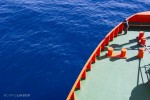
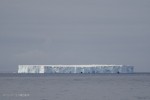
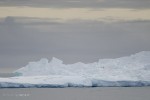
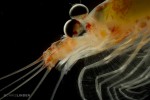
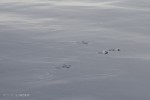
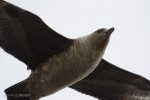
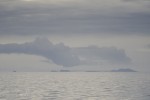
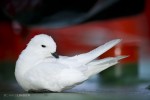







4 Responses to “To Cape Adare”